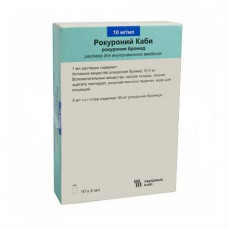Expiration date: 06/2026
Dosage and administration:
Intravenously the form of a bolus or continuous infusion.
The dose of rocuronium bromide, as well as other muscle relaxants, should be selected individually. When choosing a dose should take into account the method of General anesthesia and the expected expected duration of the operation, the method of sedation and the estimated duration of artificial ventilation, the possibility of interaction with other drugs and the patient's condition. To assess neuromuscular blockade and restore neuromuscular transmission, it is recommended to use instrumental methods of control.
Means for inhalation anesthesia enhance the muscle relaxant effect of rocuronium bromide. This effect is of clinical importance during inhalation anesthesia, when a certain concentration of volatile substances is achieved in the tissues. Accordingly, with prolonged inhalation anesthesia (more than 1 h), it is necessary to introduce smaller maintenance doses of rocuronium bromide at long intervals or reduce the rate of infusion of the drug.
The following are General recommendations on the dosage regimen of rocuronium bromide for tracheal intubation and muscle relaxation during short and long-term surgical interventions in intensive care units.
Rocuronium bromide is intended for single use only.
Surgery
Tracheal intubation: the standard dose of rocuronium bromide during normal anesthesia is 0, 6 mg/kg. This dose provides adequate conditions for intubation within 60 s in almost all patients.
During rapid sequence induction of anesthesia we recommend the use of rocuronium bromide in a dose of 1 mg/kg. After applying the specified dose of adequate conditions for intubation are also created over 60 with almost all patients. If the rapid induction of sequential anesthesia rocuronium bromide appointed at a dose of 0, 6 mg / kg, the intubation should be carried out in 90 seconds after administration.
Maintenance doses: the recommended maintenance dose of rocuronium bromide is 0, 15 mg / kg. with long-term inhalation anesthesia, it should be reduced to 0, 075-0, 1 mg/kg.the Maintenance dose is best administered at a time when the degree of muscle contractions is restored to 25% of the control level or when 2-3 responses appear during monitoring in the mode of four-digit stimulation Train of four (TOF).
Continuous infusion: drip rocuronium bromide is recommended to start with a loading dose of 0, 6 mg/kg. When neuromuscular blockade starts to recover, start a continuous infusion of the drug. Infusion rate is selected so as to maintain the degree of muscle contractions at 10% of the control value or to maintain 1-2 response when monitoring in TOF mode.
Intravenously anesthesia in adult patients, the infusion rate required to maintain neuromuscular blockade at the specified level is 0, 3-0, 6 mg / kg / h. in inhalation anesthesia, the infusion rate is 0, 3-0, 4 mg/kg/h.
It is necessary to constantly monitor the degree of neuromuscular blockade, because the required infusion rate differs in different patients and depends on the method of anesthesia.
Dosage regimen in children: children over 3 months-the recommended dose of rocuronium bromide during intubation during inhalation anesthesia and maintenance doses are similar to those in adults and are 0, 3-0, 6 mg/kg / h, and with inhalation anesthesia-0, 3-0, 4 mg/ kg / h.
The rate of continuous infusion in adolescents is the same as in adults, but children may need a higher rate of infusion.
In children, the infusion begins with the same speed as in adults. In the future, the infusion rate is selected to maintain the degree of muscle contractions at 10% of the control value or to maintain 1-2 responses when monitoring in TOF mode.
Experience with the use of rocuronium bromide in children with rapid sequential induction of anesthesia is limited. In this regard, rocuronium bromide is not recommended for use in children to facilitate intubation of the trachea with rapid introduction to anesthesia.
There are no data on the use of rocuronium bromide in infants under 1 month of age.
The dosing regimen in the elderly and patients with diseases of the liver, biliary tract and/or renal failure: the standard intubation dose of rocuronium bromide inhalation anesthesia in the elderly and patients with diseases of the liver, biliary tract and/or kidney failure is 0, 6 mg/kg. During rapid sequence induction of anaesthesia patients, which increases the duration of action of the drug, the dose can be 0, 6 mg/kg, however adequate conditions for intubation can be created only after 90 seconds after administration of rocuronium bromide.
Regardless of the method of General anesthesia, the recommended maintenance dose of rocuronium bromide is 0, 075-0, 1 mg / kg, and the infusion rate is 0, 3-0, 4 mg/kg/h.
Dosage regimen in obese patients: in obese patients (body weight 30% or more than ideal) it is necessary to reduce the dose taking into account the weight without adipose tissue.
Intensive care
Tracheal intubation: rocuronium bromide is used in the same doses as in surgical procedures.
Dosage while maintaining artificial lung ventilation: it is recommended to start with a dose of 0, 6 mg/kg, and with the restoration of neuromuscular conductivity up to 10% or 1-2 responses with stimulation in the TOF mode, start injecting I / o in the form of a bolus or continuous infusion. Doses of rocuronium bromide should be selected individually. The recommended rate of administration in adult patients 0, 3-0, 6 mg/kg / h for the first hour, after which for 6-12 hours it is necessary to reduce the rate of administration in accordance with the individual reaction of the patient.
The amount of sodium in one dose Of rocuronium CABI, equal to 1 mmol (23 mg), can be considered as insignificant.
Storage conditions:
Storage at a temperature of 30 °C for 12 weeks, after which the drug can not be used.



